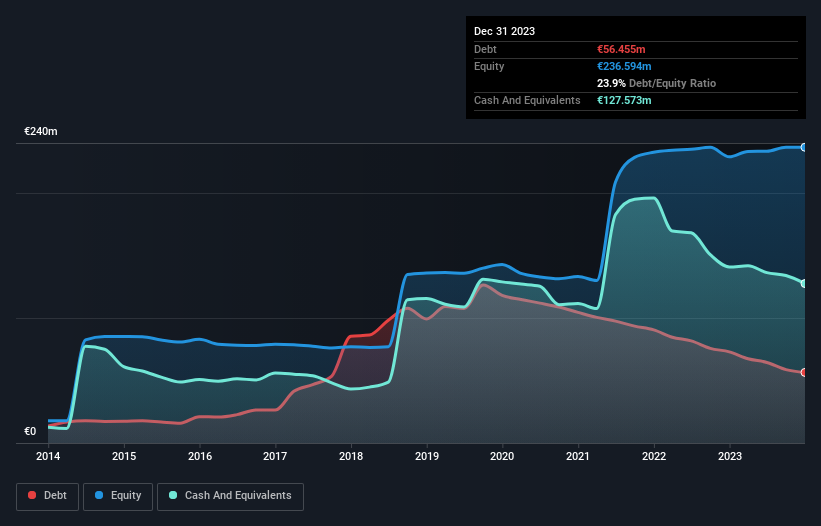
Howard Marks put it nicely when he said that, rather than worrying about share price volatility, 'The possibility of permanent loss is the risk I worry about... and every practical investor I know worries about.' It's only natural to consider a company's balance sheet when you examine how risky it is, since debt is often involved when a business collapses. We can see that Materialise NV (NASDAQ:MTLS) does use debt in its business. But should shareholders be worried about its use of debt?
When Is Debt Dangerous?
Generally speaking, debt only becomes a real problem when a company can't easily pay it off, either by raising capital or with its own cash flow. Part and parcel of capitalism is the process of 'creative destruction' where failed businesses are mercilessly liquidated by their bankers. While that is not too common, we often do see indebted companies permanently diluting shareholders because lenders force them to raise capital at a distressed price. By replacing dilution, though, debt can be an extremely good tool for businesses that need capital to invest in growth at high rates of return. When we think about a company's use of debt, we first look at cash and debt together.
Check out our latest analysis for Materialise
What Is Materialise's Debt?
You can click the graphic below for the historical numbers, but it shows that Materialise had €56.5m of debt in December 2023, down from €72.9m, one year before. But it also has €127.6m in cash to offset that, meaning it has €71.1m net cash.

A Look At Materialise's Liabilities
The latest balance sheet data shows that Materialise had liabilities of €105.0m due within a year, and liabilities of €55.1m falling due after that. On the other hand, it had cash of €127.6m and €52.7m worth of receivables due within a year. So it actually has €20.2m more liquid assets than total liabilities.
This short term liquidity is a sign that Materialise could probably pay off its debt with ease, as its balance sheet is far from stretched. Simply put, the fact that Materialise has more cash than debt is arguably a good indication that it can manage its debt safely.
We also note that Materialise improved its EBIT from a last year's loss to a positive €5.6m. When analysing debt levels, the balance sheet is the obvious place to start. But ultimately the future profitability of the business will decide if Materialise can strengthen its balance sheet over time. So if you want to see what the professionals think, you might find this free report on analyst profit forecasts to be interesting.
Finally, while the tax-man may adore accounting profits, lenders only accept cold hard cash. While Materialise has net cash on its balance sheet, it's still worth taking a look at its ability to convert earnings before interest and tax (EBIT) to free cash flow, to help us understand how quickly it is building (or eroding) that cash balance. Happily for any shareholders, Materialise actually produced more free cash flow than EBIT over the last year. There's nothing better than incoming cash when it comes to staying in your lenders' good graces.
Summing Up
While we empathize with investors who find debt concerning, you should keep in mind that Materialise has net cash of €71.1m, as well as more liquid assets than liabilities. The cherry on top was that in converted 149% of that EBIT to free cash flow, bringing in €8.4m. So we don't have any problem with Materialise's use of debt. Above most other metrics, we think its important to track how fast earnings per share is growing, if at all. If you've also come to that realization, you're in luck, because today you can view this interactive graph of Materialise's earnings per share history for free.
If you're interested in investing in businesses that can grow profits without the burden of debt, then check out this free list of growing businesses that have net cash on the balance sheet.
Valuation is complex, but we're here to simplify it.
Discover if Materialise might be undervalued or overvalued with our detailed analysis, featuring fair value estimates, potential risks, dividends, insider trades, and its financial condition.
Access Free AnalysisHave feedback on this article? Concerned about the content? Get in touch with us directly. Alternatively, email editorial-team (at) simplywallst.com.
This article by Simply Wall St is general in nature. We provide commentary based on historical data and analyst forecasts only using an unbiased methodology and our articles are not intended to be financial advice. It does not constitute a recommendation to buy or sell any stock, and does not take account of your objectives, or your financial situation. We aim to bring you long-term focused analysis driven by fundamental data. Note that our analysis may not factor in the latest price-sensitive company announcements or qualitative material. Simply Wall St has no position in any stocks mentioned.
This article has been translated from its original English version, which you can find here.
